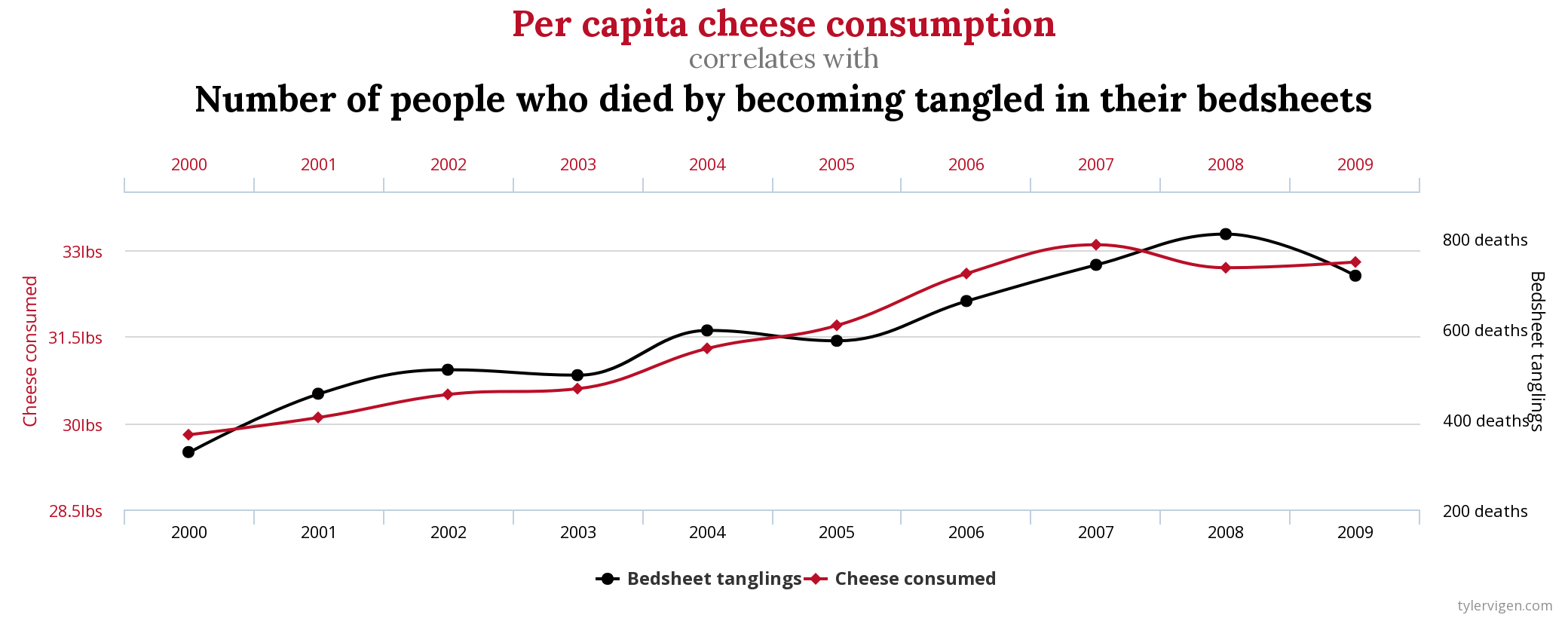
Slack Investor is a lover … of cheese. He follows all cheese related literature and was shocked by the revelation that “Death by Bedsheet Entanglement” is highly correlated (0.95 Pearson R correlation) with cheese consumption. The thought that over 800 people died in the US in 2008 at the hand of their sleeping equipment is terrifying.
A quick explainer on the correlation coefficient, it is just a way to measure how strong the relationship is between two variables. The correlation coefficient ranges between +1.00 (perfect positive correlation) through zero (no correlation) to -1.00 (negative corrrelation)

Slack Investor salutes Tyler Vigen here – a bloke who wrote a program that crawls through unrelated government data sets to find spurious correlations. The above chart is one of these random pairs of data that were thrown together by his program. Almost 50 000 of these graphs that show unlikely correlations have been found so far – and one more is produce every minute! Hats Off Tyler.
Correlation does not mean causation
First lecture in Statistics 101
In the cheese consumption case, it is hard to think that eating cheese actually causes bedsheet entanglement. The first step when trying to establish a link between two variables is correlation. Then, most importantly, experiments must be done to show that A actually causes B – Is there a reason that makes sense? Some people link cheese to nightmares, but there is no scientific evidence linking cheese to death by bedsheet … so, this high correlation is probably just due to chance and a limited data set (10-yr). There is likely to be a missing other variable that’s the true driver that causes the correlation. I would speculate that both variables might be linked to general population trends – but this would have to be tested.
Using Sector Correlations in Investing
Slack Investor has been banging on a bit about “Sectors” lately. and despite not feeling the need to match his portfolio with the sectors of the S&P 500 (Or ASX 200), sector analysis can be useful.
My Investments portfolio consists mostly of “growth stocks” in the Technology and Healthcare sectors. The table below shows a high correlation of these sectors with the total market – they will tend to move with the general market during an occasional downturn. The Nasdaq Composite is down about 23% from its November 2021 high – the Slack growth portfolio is down about 7 % so far this financial year – Not fun, but I do expect the occasional down year.

However, I want my Stable Income pile, 30% of non-house wealth, to be much more conservative. It holds annuities, fixed interest products and some shares. The shares in the Stable pile need to have a low correlation with the general stock market – as, when the stock market does poorly, I want this pile to be OK.
For my Stable pile, I choose stock sectors that are not highly correlated with stock market fluctuations (circled in red below). I already have some REITS (Listed Real Estate – Correlation 0.59), and some Consumer Staples (Correlation 0.57) which Perhaps I should buy some more Utilities and REITS (real estate). When I get an opportunity, I would like to buy some Utilities (Correlation 0.40) for the Stable pile.
I am always on the lookout for spurious correlations and the 19-year data set, in the above table seems sufficient (would like longer!). Do the correlations make sense? For example, it seems reasonable that Utilities would have a low correlation with the general market. It is a sector that would be able to keep its earnings and maintain its stock price – even during a market downturn.
An asset that has an even lower correlation to the S&P 500 is Gold – and is often seen as a “hedge” to to the stock market. Over a 20-yr period (2000-2020), Gold has a correlation of -0.28 with Australian Equities and -0.12 with Global Equities
Gold has a low (and at times, negative) correlation to other assets
ETF Securities
Smarter people than Slack Investor provide compelling reasons for including Gold in your portfolio – to improve long term returns. But the pig-headed Slack Investor has not yet overcome his old fashioned view that Gold is a speculative investment that does not earn a dividend or interest.
April 2022 – End of Month Update
Slack Investor remains IN for Australian index shares and the FTSE 100 but OUT for the US Index S&P 500 due to a sell – back in January 2022.
Despite some big daily fluctuations, the FTSE 100 (+0.4%) and The ASX 200 (-0.9%) ended relatively flat this month. All is not well in the USA where inflation fears and some mixed results from the Tech sector allowed the S&P 500 to fall -8.8%.
All Index pages and charts have been updated to reflect the monthly changes – (ASX Index, UK Index, US Index).

